Suppose we are interested in mean decay rate of a compound i
Suppose we are interested in mean decay rate of a compound in the Mill River. Determine the mean decay rate is greater than 3.0 per day. When you test a random sample of size 15, the sample mean decay rate is 3.15. If an assumed known standard deviation of sample is 0.20 per day.
a) What are the appropriate hypotheses?
b) What is the rejection region for 1%?
c) Test hypothesis with the significance level of 1% and explain your conclusion.
d) What is p-value? Compare the conclusion using the same significant level of 1% with previous hypothesis testing.
e) Find a 99% confidence interval for the mean decay rate and compare the conclusion with previous hypothesis testing and p-value.
Solution
a)
Formulating the null and alternative hypotheses,
Ho: u <= 3
Ha: u > 3 [ANSWER]
***************
b)
As we can see, this is a right tailed test.
Thus, getting the critical t,
df = n - 1 = 14
tcrit = + 2.624494068
So, reject Ho if t > 2.62449. [ANSWER]
****************
c)
Getting the test statistic, as
X = sample mean = 3.15
uo = hypothesized mean = 3
n = sample size = 15
s = standard deviation = 0.2
Thus, t = (X - uo) * sqrt(n) / s = 2.90473751
As t > 2.62449, we Reject Ho. Thus, there is significant evidence that the mean decay rate is greater than 3.0 per day. [CONCLUSION]
********************
d)
Also, the p value is
p = 0.005766781 [ANSWER]
*******************
E)
Note that
Lower Bound = X - t(alpha/2) * s / sqrt(n)
where
alpha = (1 - confidence level) = 0.01
X = sample mean = 3.15
t(alpha) = critical t for the confidence interval = 2.624494068
s = sample standard deviation = 0.2
n = sample size = 15
df = n - 1 = 14
Thus,
Lower bound = 3.014471709
Thus, the confidence interval is u > 3.01447. [ANSWER]
As this whole interval is greater than 3.0, then it is consistent as earlier: there is significant evidence that the mean decay rate is greater than 3.0 per day.


 Homework Sourse
Homework Sourse